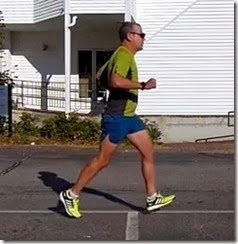 If you’ve followed this blog over the past six months you’ll know that I resigned from a 10-year career as a college professor back in May. Aside from my desire to pursue this blog on a more full-time basis, a second big motivator for leaving academia was that I had an offer to work out of a local injury clinic as an exercise physiologist and gait analyst.
If you’ve followed this blog over the past six months you’ll know that I resigned from a 10-year career as a college professor back in May. Aside from my desire to pursue this blog on a more full-time basis, a second big motivator for leaving academia was that I had an offer to work out of a local injury clinic as an exercise physiologist and gait analyst.
My buddy Brett Coapland is a chiropractor who specializes in manual therapy and treating athletic injuries, and he also happens to be a pretty competent ultrarunner (11th place overall at the VT 50K this year!). I’d helped Brett out from time to time with gait analyses, and he happened to be looking to expand his practice. He was moving into a new office, and there would be room for me to work out of the clinic if I wanted to, and I jumped at the chance. I’m now working 3 days a week at Performance Health Spine and Sport Therapy doing gait analysis and a bit of coaching, and it’s been a blast so far.
Last week a fellow shoe geek and running blogger stopped by for a visit and a run. I’ve known Sam Winebaum for a long time as a fellow blogger (he writes Sam’s Running, People, Places, and Things), and he often sends me reports from the Outdoor Retailer shows since he spends a lot of time doing consulting work in Utah. I offered to film Sam for fun while he was in town, so we hit the parking lot and shot a bit of video (I do my filming outdoors whenever possible).
Sam is not injured, so this wasn’t a clinical visit. In fact, he just recently finished the St. George Marathon in a time of 3:33. His marathon PR is 2:28 (“many moons ago” as he puts it), and he’s finished in the top 15 at the Mount Washington Road Race on 3 occasions in his life (he was second junior in the race one year!).
We thought it might be fun to share his videos and let you critique them. As I mentioned, he’s not suffering from an injury, but he does feel like his stride has lost a bit of its pop as he’s gotten older. It’s also worth pointing out that he is well aware of his right foot turning out, it stems from a childhood injury that never quite healed properly. He currently is running in Hokas, the adidas Adios Boost, and the adidas Energy Boost.
If you have any form suggestions to help him find his pop, fire away! (I shared my thoughts with him already, but wanted to keep out of it here). Have fun!
Note – these videos are shot at 120fps in HD – you can turn on the HD quality version by adjusting the settings under the little gear icon on the bottom right in the YouTube windows.
Side View
Foot Strike Close-up
Rear View – Whole Body
Rear View – Close-up of Feet
Front View
So what do you think?
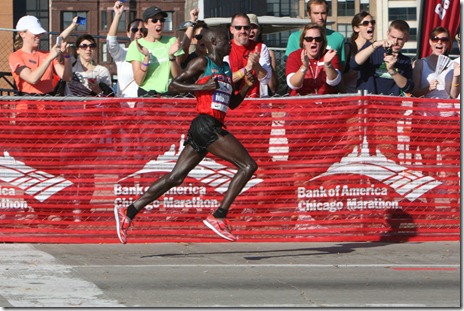
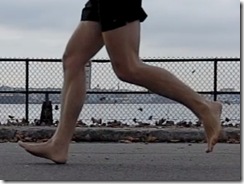
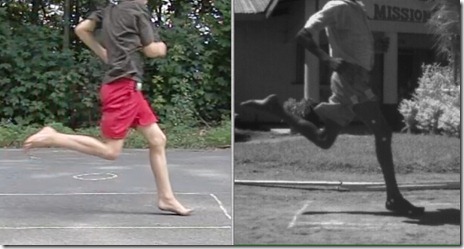
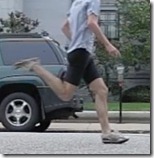















>Body imbalance, more pressure on one side
>Right arm swinging too far back meaning one leg is working harder than the other one, left side is compensating
>Core looks stable
>Overstriding
>Unnecessary dorsal flex
>Pushing off vertically too much
>Too long of a pause between each stride, meaning ground contact is too long
It’s difficult to determine cadence from the video but it looks like it may be a little slow.
And I agree with Calvin that there’s too much vertical movement, which wastes energy.
We all run a little differently though, and all in all it looks pretty good to me.
Overstriding is the main thing that I notice. Shorter strides will result in a higher cadence and hopefully will result in faster running.
Really appreciate everyone’s comments!
Wow. Just wow.
He ran 2:28 once, and 3:33 recently!? I’ll be lucky to ever run a 2:28 marathon, so he sure doesn’t need my thoughts about form. However, if I woke up tomorrow and went out and ran like this, I would probably get hurt within a couple of miles. I would then change everything–posture, arm carriage, I would focus on getting the feet aligned properly (not just the right-they both point out), shorter stride/higher stride rate/midfoot strike.
I would put on a pair of flat shoes and start from scratch.
Bob, Thanks for your input. the 2:28 was in 1980 or so. From the mid 80’s until about 10 years ago I ran 2-4 times a week. 10 years ago I got back into serious training. Average 40 a week. In all my running only 2 injuries that stopped me for any length of time: shin splints and then stress fracture in the early 80’s, plantars 6 years ago. Both caused by rapid change of surface in spring from running on snow to pavement and hills.
Well, I guess you don’t need to change anything. But if I ran like that, it would significantly increase my effort, and decrease my enjoyment. I’m kind of lazy, in that I enjoy things being easier, not harder. If your way feels good, and you are convinced that any problems were caused by things other than your form, then I guess you’re fine.
Definite heel strike; he may not care about that, and the Boost is well suited to handle that. His feet land quite a bit in front of him; ideally they would land more below him. And I’d recommend making everything move much more in a forward line (arms, feet, etc.). But then again, I’d never see him in a race, as he’d be far ahead of me.
Not sure if my last comments got through or not Pete.. but here are my 2 cents worth.
When I look at clinical gait analysis (as distinct from in a research setting with sophisticated kinetic and kinematic analysis equipment), I like to start at the head and work my way down. This gives a nice structure to the analysis and ensures gait analysis not foot analysis. so this is what i see with Sam:
– forward position of head on shoulders (the head is very heavy, and so a position forward or to the side will have a big influence on the way Sam runs)
– the head also is carried to the right
– L arm swing carries higher and further across the body than the R
– L trunk rotation with L shoulder rotated posteriorly
– R shoulder drop,with upper body lean to left (clearly seen in video 2)
– Circumduction of L arm
– sits bodyweight too far back and therefore ‘overstrides” and increases braking force at contact
– knee extension bilaterally not ideal
– poor kick
– bilaterally abducted foot position
– L>R pronation at midstance
– large vertical oscillation with loss of potential energy.
That’s it.. always interesting to see what other people see.. thanks for posting and best
Simon
To me it seems like his hip flexors or glutes are really stiff/tight, which might explain his overstriding and potentially may fix other issues posted…
On the ‘rear view whole body’ video, is it possible there’s some hip drop action happening. The hips seem all over the place, not staying parallel to the ground.
This is a pretty awesome idea. Sometimes I look at race pictures of myself and analyze my form, but this is way better.
Hey Sam and Pete,
I’m definitely not a specialized gait analysist and someone who has run 2.30 in the past and a 3.33 recently and has no injuries is someone to envy anyway, but here’s my two cents.
I’d say try to work on vertical alignment first. I find the chi-running tips work really well for me personally: making yourself as tall as possible.
Then i’d work on the arms. Keep them closer to your body, keep the angle of your elbows above 90 degrees at all times and focus on swinging the elbows back.
What helps me as well is trying to plant my feet behind my center of gravity, which is impossible in itself, but the effort itself keeps me from overstriding.
Increasing the cadence helps me keep it light as well.
And if you want pop, do some strength work. I do squats with my 8-year old on my shoulders. That really seems to work (for my son as well btw, he loves it!)
Happy running!
Hey,
I was at St. George too this year. Man was that a cold wait in the starting area!
I don’t know much about running form, but if that were my video I think I would try to get my upper body a tad further forward and my foot landing more underneath me.
I think the real benefit of this video is:
1. I should get off my butt and go do a video of myself
2. This would be a great regular feature, where different runners (pros, amateurs) submit their videos and we all look, discuss and learn about them.
“The wonderful thing about tiger is that I’m the only one, bouncy, bouncy, bouncy, bounce bounce bounce.”
To paraphrase a certain famous children’s character ;-)
I think kinda sums up how I think Sam might be able to improve on his gait. Sam currently doesn’t look to be flowing smoothly and benefiting from elastic recoil as much as he could.
Sam is definitely pulling the toes up prior to landing which will be wasting energy. While one might debate the merits of foot strike I don’t think pre-tensing the shin muscles and pulling the angle joint up into a locked position will help anyone. So I’d recommend working on relaxing the shin and ankle during recovery.
The torso/hips looks to be more rigid than they could be, so loosing up the spine and hip flexors will likely help with a more fluid gait.
While I don’t really see over striding, but then pace it pretty low. This might well effect all of the conclusions.
I think it would be pretty important to know what pace he is running at in the video (by HR zone or RPE?) and how fatigued he is in the video. We’ve seen huge changes based on these factors…
That said, the interesting thing I see is a lack of re-supination. We’ve seen in the lab that this can sometimes rob the power that our body is putting into the ground, and might make it feel like he has less ‘pop’.
Also–thx for shooting in 120fps!
Main observation is that foot lands forward. Suggest working to get landing more beneath him. Best form thought is to roll hips slightly underneath and think of bending at the ankles (NOT at the waist) and letting ankles trail (rather than leading with your knees/feet). This works well with a quicker cadence (~ 170-180/min).
I’m definitely not a gait analysis expert, but I did go in and have my gait analyzed a month ago…and it was pretty bad (apparently). I do see some similarities between Sam’s gait and mine, in that his foot strikes ahead of his body and its a heel strike (not as pronounced as mine though). I wouldn’t have noticed anything, except I was told I do the same thing!
* Slight Trendelenburg sign in R stance, so perhaps some right glute min/med weakness.
* More toe-out on R. There’s some toe-out bilaterally, but it’s more pronounced on the R. If the R hip is externally rotated, this can potentially fall in line with tight/weak glutes, and probably tight piriformis (or gemellus or obturators), which would fall in line with the Trendelenburg sign.
* Very slight R knee valgus at midstance. Not surprising given the last two findings.
* L arm circumduction
* Looks to be some L rotation and L lateral flexion that starts no higher than the pelvis or lumbar spine (though it’s possible it originates even lower than that), but it’s hard to tell just from that clip.
* Body weight appears pretty far back. This could be due to anything from tight QL or hamstrings, to weak core (which goes hand in hand with tight QL/hamstrings), to nutated sacrum (which would most likely be caused by weakness or tightness of the aforementioned muscles) to hyperlordosis of the lumbar spine (which again could be caused by tight back extensors).
* Slight forward head carriage. Would not be a surprising finding if there’s sacral nutation or lumbar hyperlordosis.
But we’re looking at a guy who is clearly fast, and is currently healthy. If he were my patient, I’d treat any little aches and pains he had and then send him on his way. No need to mess with what works. Maybe give him some hip stretches and exercises if he insists, but nothing too intense…don’t see much need.
I’m not an expert but it seems to me the whole thing is very stiff and quite asymetrical. And as a lot of people have already said, there’s the overstriding and the heel strike.
All that being said, I’ll never run a marathon in under 2:30 and I’ve never seem myself run, so who am I to tell?
Pete, can we have your thoughts too?
Yes, planning to do a post on it.
—-
Pete Larson’s Web Links:
-Performance Health Spine and Sport Therapy<http: about-us=”” dr-peter-larson=”” performancehealthnh.com=””>
-My book: Tread Lightly: link to ow.ly
-Blog: https://runblogger.com
-Twitter: link to twitter.com
-Facebook Page: link to facebook.com…
-Discussion Forum: https://runblogger.com/forum</http:>
Sam, I used to run like that. I transitioned to barefoot style. I think you would really enjoy it! It’s complicated but if you do your research and avoid TMTS (too much too soon) you may find a whole new dimension and increased enjoyment from your running. More importantly, you are more likely in my opinion to be able to keep running for decades rather than nadgering (technical term!) your knees, hips and back from all that heel striking.